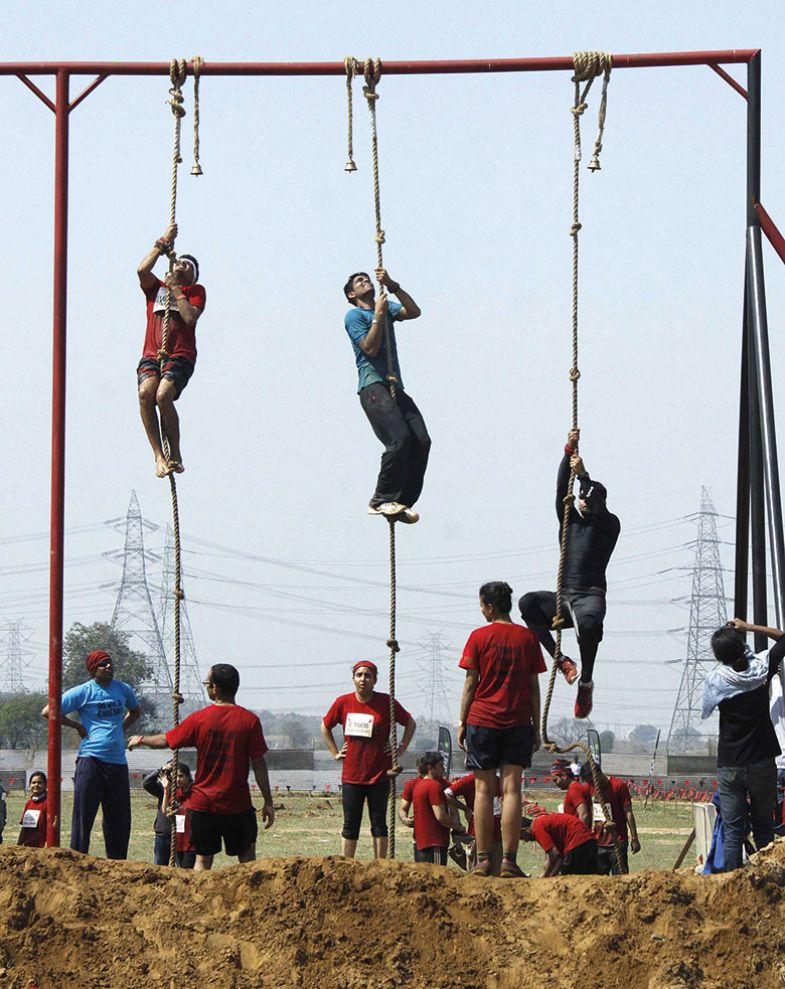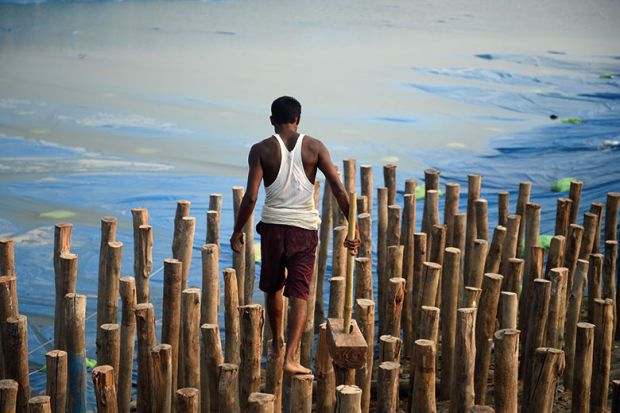Browse the full results of the World University Rankings 2020
Despite India’s large higher education system, rapidly growing economy, use of English-language instruction and low-cost education, the country’s universities have historically been very weak when it comes to attracting international academics and students. On average, less than 2 per cent of students and 1.5 per cent of staff on the 56 Indian campuses included in the Times Higher Education World University Rankings 2020 are from outside the country. Twenty-six universities have no international academic staff, and nine have no international students.
But while the world is still not coming to Indian universities, some institutions are more proactively going out into the world in a bid to reap some of the benefits of internationalisation.
Sarit Das, director of the Indian Institute of Technology Ropar, says the university is recruiting young academics who are currently working, or who have recently completed postdocs, at universities in places such as London, Toronto, Chicago, Boston, Singapore and Sydney. “We are holding interviews there only and give offers to the competent candidates to join IIT Ropar,” he says, adding that some are given a “generous seed grant” to set up laboratories and produce quality research.
In addition, in 2017, a “summer visitation programme” was launched to “send good performing faculty to the top laboratories of the world for a month for research collaborations”.
IIT Ropar is the highest-ranked Indian newcomer in this year’s table, ensconced in the 301-350 band thanks to its very high score for citation impact and its reasonably strong showing on the industry income measure. Das says the university has established key areas of research focus, which include water, cancer research, environmental issues, electric vehicles, microgrid technology, artificial intelligence and big data, and the treatment of drug addiction.
Meanwhile, a new research collaboration with the Massachusetts Institute of Technology’s Abdul Latif Jameel Water and Food Systems Lab and a new Indo-Taiwan joint research centre on artificial intelligence and machine learning are already “showing results in terms of research quality and global outreach”, he says.
IIT Ropar ranks alongside the country’s flagship, the Indian Institute of Science, which has fallen out of the 251-300 band because of a decline in its citation impact score. It is the first time that an Indian university has not featured in the top 300 of the ranking since 2012, when just a single institution from the country, the Indian Institute of Technology Bombay, was ranked.

Das says India’s “need of the hour is significant enhancement in government-led investment in higher education”, adding that its “lack of ability to lure global faculty due to resource constraints is pulling down Indian universities in global rankings”.
Although the government has “shown its intent to attract global talent…the amount of investment in this direction is subcritical”, he says.
In contrast, he goes on, China’s high level of funding for higher education is producing competitive laboratories, infrastructure and salaries and enabling the country to attract academics and students from around the world.
Nevertheless, although Indian universities continue to struggle when it comes to internationalisation, THE data show that they are improving in other areas. The country’s higher education sector has much higher average scores for citation impact and research reputation this year, driven by bigger amounts of research income and more doctorates awarded.

India’s representation in the ranking has also improved. In 2016, just 17 Indian universities featured among the top 800; that number has risen to 23 this year. Overall, India’s share of institutions in the full ranking has doubled to 4 per cent during the same period.
Das attributes these improvements to a string of government initiatives aimed at boosting the number of researchers and the quality of research in the country.
“Higher education in India is undergoing substantial change,” he says.
“The institutions and universities have not only become more diverse in type, ownership and educational offerings, they have also diversified their missions, targeting all groups of students, serving specific local or regional needs, specialising in some niche areas, or establishing close links with specific industries and corporations.”
Craig Jeffrey, director of the Australia India Institute and professor of geography at the University of Melbourne, attributes India’s research progress to the “sustained attention it is giving to recruiting and retaining talent within India and from abroad and because of the drive that India is making to internationalise its higher education, which depends on enhancing quality”.
Last year, the Indian government launched a new internationalisation strategy aimed at swelling the number of foreign students from 47,000 to 200,000 in the next five years by targeting 30 countries across south Asia, Africa, the Middle East and the former Soviet republics. The longer-term aim is to attract 1 million foreign learners to the country.
Meanwhile, earlier this year, the country published a draft National Education Policy (NEP), which proposes to consolidate institutions into large, multidisciplinary universities and create a differentiated higher education system.
Jeffrey says that although it is difficult to predict the effect of these reforms, there are “a lot of good ideas” in the draft NEP, among them focusing on mentorship, leveraging the strengths of the Indian diaspora and boosting research funding.
Another strength of the policy is that it “avoids a tight focus on polishing the top Indian higher education institutions to concentrate instead on seeking to spread a research culture to India’s state universities and provincial institutions”.
“If it is implemented well, the NEP could create new pipelines of talented researchers and improve rankings [performance] in the long term,” he says.
“I think it is very likely that India will have a university in the top 200 in five years’ time. I think this may come about through India’s focusing effort on two or three ‘pinnacle institutions’ and/or via partnerships with a university abroad to create a type of blended institution.”

Elsewhere in south Asia, Sri Lanka’s University of Peradeniya joins the ranking in the 401-500 band, doubling the country’s representation to two institutions. The University of Colombo remains in the 1,001+ band.
Meanwhile, Pakistan’s Quaid-i-azam University is back in the table in the 401-500 band, leading the country’s 14 representatives.
There are also some significant improvements further east. Macau University of Science and Technology is a new entry in the 251-300 band, becoming the top-ranked institution in the territory, while Thailand’s Mae Fah Luang University makes its debut in the 601-800 band, alongside its flagship institution, Mahidol University.
There are also some Asian countries that feature for the first time. One is Brunei, with Universiti Brunei Darussalam joining the 401-500 band. Another is Vietnam, which has three representatives: Hanoi University of Science and Technology (HUST) and Vietnam National University, Hanoi in the 801-1,000 band and Vietnam National University (Ho Chi Minh City) in the 1,001+ group.
The Vietnamese universities tend to achieve their highest scores for international outlook and industry income, but lag behind when it comes to their research environment.
Hoang Minh Son, president of HUST, which aims to become the top research university in the south-east Asian region by 2030, says a revised higher education law that came into effect in July has ushered in a period of reform in Vietnam. Significant developments include focusing on improving the quality of universities instead of increasing student enrolment (which had been the strategy for the past decade); increasing the autonomy and accountability of institutions; and boosting international collaborations.
“Many universities are developing and strengthening international research collaboration networks as a way to enhance their capacity, their international outlook and their reputations,” he says, adding that Vietnam’s total number of international publications indexed by Clarivate Analytics’ Web of Science quintupled between 2008 and 2018. As a result, Vietnam has overtaken Indonesia to rank fourth in south-east Asia on this measure, behind Singapore, Malaysia and Thailand. Malaysia’s number of international publications tripled over the same period, while Thailand’s increased by 150 per cent.
Son says that as part of the move to bolster university autonomy, the government’s higher education funding model will switch from a block grant system to one based on performance and competition.
“As a consequence, it can be foreseen that the gap between strong and weak universities will grow bigger,” he says.
One of the main challenges for Vietnamese universities, Son explains, is that the state spends only 0.25 per cent of its gross domestic product on higher education – one of the lowest shares for a country at its level of development. And while this paucity of investment has led institutions to propose raising tuition fees in a bid to improve quality, most families in Vietnam cannot afford to pay bigger bills, he says.
Elsewhere, Latin America can celebrate some signs of progress, with Puerto Rico and Cuba joining the ranking for the first time.
The University of Puerto Rico enters the 801-1,000 band, achieving relatively high scores for citation impact and international outlook, while the University of Havana claims a place in the 1,001+ group, scoring best for international outlook and industry income.

Some previously ranked institutions in the region have also made gains. Mexico’s Metropolitan Autonomous University has jumped one band to join the 601-800 group, reflecting a large boost in its citation impact score. It is now jointly the country’s top-ranked institution, alongside the Monterrey Institute of Technology and the National Autonomous University of Mexico.
In Colombia, the top-ranked Pontifical Javeriana University rises from the 501-600 band to the 401-500 group – the highest position for a Colombian institution since 2015 – again thanks to improvements in its citation impact score.
Jorge Humberto Peláez Piedrahita, rector of the institution, says the number of professors with PhDs at the university has shot up by nearly 63 per cent since 2012, while almost 65 per cent of academics at the university obtained their highest degree in a different institution, enhancing their ability to collaborate with other universities.
The university has incentives for academics to “improve their relations with other professors abroad”, he adds.

In Europe, Russia is making significant improvements, with its four leading universities all rising up the table. Its flagship, Lomonosov Moscow State University, sits at joint 189th, up from joint 199th, reflecting increases in its scores for research productivity, share of doctorates awarded and research income. The Moscow Institute of Physics and Technology, the Higher School of Economics and ITMO University have also each moved up a band.
Meanwhile, Montenegro and Malta make their inaugural appearances in the table. The University of Montenegro ranks in the 1,001+ band, while the University of Malta joins the 601-800 group, recording its highest scores for international outlook and citation impact.
Godfrey Baldacchino, the institution’s pro rector for internationalisation, says that 10 per cent of Malta’s student body come from overseas, while about 400 foreign students are on campus for a full semester each year through exchange and mobility programmes.

The university has two distinct advantages in its bid to recruit international students. It is one of only two state-funded universities in the Mediterranean where English is the language of instruction, and Maltese residents – and, by extension, those hailing from the European Union – do not pay tuition fees for any undergraduate programmes, Baldacchino says.
The university understands that “rankings can influence and even sway student decisions (and, in some countries, the advice of their parents) as to where they should consider studying”, he explains, so it encourages all its academic staff “to be more assertive when it comes to publicising their scholarship”.
Like many universities worldwide, Baldacchino highlights funding for research as the institution’s foremost challenge. Given Malta’s small economy, the archipelago has “relatively few corporate champions to inject significant funding into research projects”, he says.
As the only public university in Malta, the institution is also “fully cognisant of the imperative to reach out, build and nurture academic networks with colleagues from elsewhere”.
In June, it was announced that the university was among the successful bidders for the first networks of “European universities”, initially proposed by France’s president, Emmanuel Macron. In total, 17 networks involving 114 universities from 24 countries were selected.
“Almost all academics at the University of Malta have secured their qualifications from overseas universities. Moreover, once we have developed a specialist expertise, it is more likely that we will find collaborative opportunities internationally and regionally, rather than domestically,” Baldacchino says.
“Introversion is not an option.”
Register to continue
Why register?
- Registration is free and only takes a moment
- Once registered, you can read 3 articles a month
- Sign up for our newsletter
Subscribe
Or subscribe for unlimited access to:
- Unlimited access to news, views, insights & reviews
- Digital editions
- Digital access to THE’s university and college rankings analysis
Already registered or a current subscriber? Login







